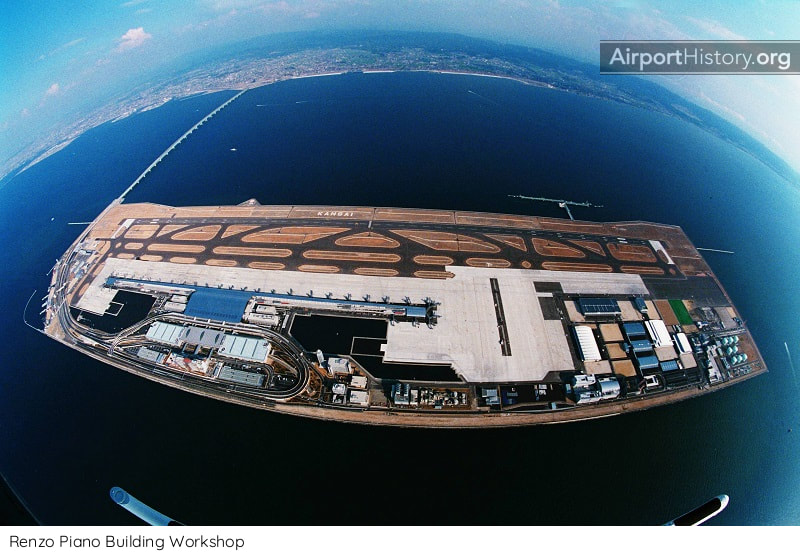|
Kansai International Airport (KIX) is the world’s first ocean airport, built on a landfill island in Osaka Bay, Japan. Opened in 1994, KIX was a modern engineering marvel, built entirely as an artificial island.
The project is not entirely without its problems; the island has been subsiding much quicker than was originally anticipated. In this post we present you a series of fantastic images showing how Kansai Airport evolved over the years.
BACKGROUND
Osaka's original international airport, Itami Airport, located in the densely populated suburbs of Itami and Toyonaka, was surrounded by buildings. It could not be expanded and many of its neighbors had filed complaints because of noise pollution problems. After the protests surrounding New Tokyo International Airport (now Narita International Airport), which was built with expropriated land in a rural part of Chiba Prefecture, planners decided to build the airport offshore on an artificial island. The size of the island would be 2.5 miles (4 kilometers) and 1.6 miles (2.5 kilometers) wide. The island would not only have to provide a solid foundation for the airport facilities but also be able to withstand the risks of typhoons, waves and earthquakes.
Construction of Kansai Airport started in 1987. First, a sea wall made of rock and 48,000 tetrapods was built and completed in 1989. Then the seabed, located at 60 feet (18 meters) below sea level, was strengthened.
This image shows the state of affairs in 1990, after the area within the sea wall was filled with layer upon layer of earth. Construction engineers dredged soil from Osaka Bay, quarried more from nearby mountains and even barged it in from China and Korea to build up the layers.
At several stages of the work to heap new soil on the seabed, operations paused to allow the new level to consolidate and sink. As the dredging and filling continued, the added layers reached up to 65 feet (20) above sea level. Note the outline of the future terminal, which is clearly visible (middle). Construction of the terminal started in in 1991.
By 1993, the airport was clearly taking shape. Construction of the airport facilities was carried out in 38 months by 6,000 workers.
An early 1994 image of the nearly completed airport. Centerpiece of Kansai Airport is the Renzo Piano-designed passenger terminal, whose roof is shaped like an airfoil. This shape helped to naturally cool the building.
Like this article?
Support us by donating just $2.95 and receive a fantastic KIX download!
For the price of a cup of coffee you can help our mission to protect & preserve the heritage of the world's great airports!
As a token of our thanks you will receive a digital download of a fascinating, 16-page 1988 brochure introducing the 'future' Kansai International Airport!
Or you can make a simple donation
Click below to support.
A fantastic image showing the completed airport, just before opening on September 4, 1994.
The 2.3-mile (3,750-meter) bridge connects the island to the mainland at Rinku Town. The bridge was completed in 1990 at a cost of USD 1 billion.
An aerial view of Terminal 1 shortly after opening. With a length of 1.1 miles (1.7 kilometers), it is the longest terminal building in the world. Unlike its predecessor in the city, Kansai is open 24 hours a day.
The construction of the seawall for Kansai's Phase 2 expansion was nearly complete in this November 2001 image.
This October 2005 image shows completion of the landfill and the foundation for the second runway.
Initially, Kansai’s islands were predicted to evenly settle--or as engineers say, "subside"--over a 50-year period before stabilizing at 13 feet (4 meters) above sea level. That’s the minimum elevation required to prevent flooding in case a breach develops in an encircling seawall. However, portions of the first island created reached that threshold within six years. At least USD 150 million was spent to raise the seawall, but some engineers predict that by 2056, sections of the two artificial islands may sink 13 more feet to sea level.
The second runway was opened in August 2007. This image was taken in 2014, after completion of Terminal 2 (completed 2012) and the FedEx hub (2014).
A close up view of Terminal 2, which is dedicated to low-cost airlines. The terminal was expanded in 2017.
In September 2018, Kansai Airport was flooded due to Typhoon Jebi, the most powerful storm to hit Japan in 25 years. At the height of the storm, 16-foot (5-meter) waves spilled over the sea wall.
In 2019 a three-year project began to raise the height of the seawalls and to raise the elevation of the 11,500-foot (3,500-meter) runway by 3.3 feet (1 meter) by using asphalt. It's clear that the island's subsidence, coupled with climate change poses a great challenge for Kansai Airport in the medium and long term. Despite this, the project stands as a great feat of engineering. The expertise gained with building Kansai has been utilized to prevent future problems with newer sea airports such as Centrair (Nagoya) and Kobe airports. What are your thoughts about Kansai Airport? Leave your comments below! I want to extend a warm thank you to Bruno Ekberg for making available the KIX brochure for download!
More airport articles: Click here
Want more stunning airport photos & stories?
Sign up to our newsletter below to know when new content goes online!
0 Comments
Your comment will be posted after it is approved.
Leave a Reply. |
With a title inspired by the setting of the iconic 70s film "Airport", this blog is the ultimate destination for airport history fans.
Categories
All
About me
Marnix (Max) Groot Founder of AirportHistory.org. Max is an airport development expert and historian. |














 RSS Feed
RSS Feed